Balance scorecard: an overview
VerifiedAdded on 2021/06/15
|17
|4129
|371
AI Summary
Management accounting16 RUNNING HEAD: MANAGEMENT ACCOUNTING Balance scorecard Contents Introduction 2 Part 1 2 Client’s description – Rockwater Limited BSC 2 Part B 3 Introduction of Balance scorecard and its features 3 Part c 8 Traditional approaches BSC VS Balance Scorecard 8 Part D 11 Suitability of the approach to the client. The first part deals with the detail description of the client which is Rockwater Limited, a wholly owned subsidiary of Brown & Root/Halliburton which is a global engineering and construction company
Contribute Materials
Your contribution can guide someone’s learning journey. Share your
documents today.
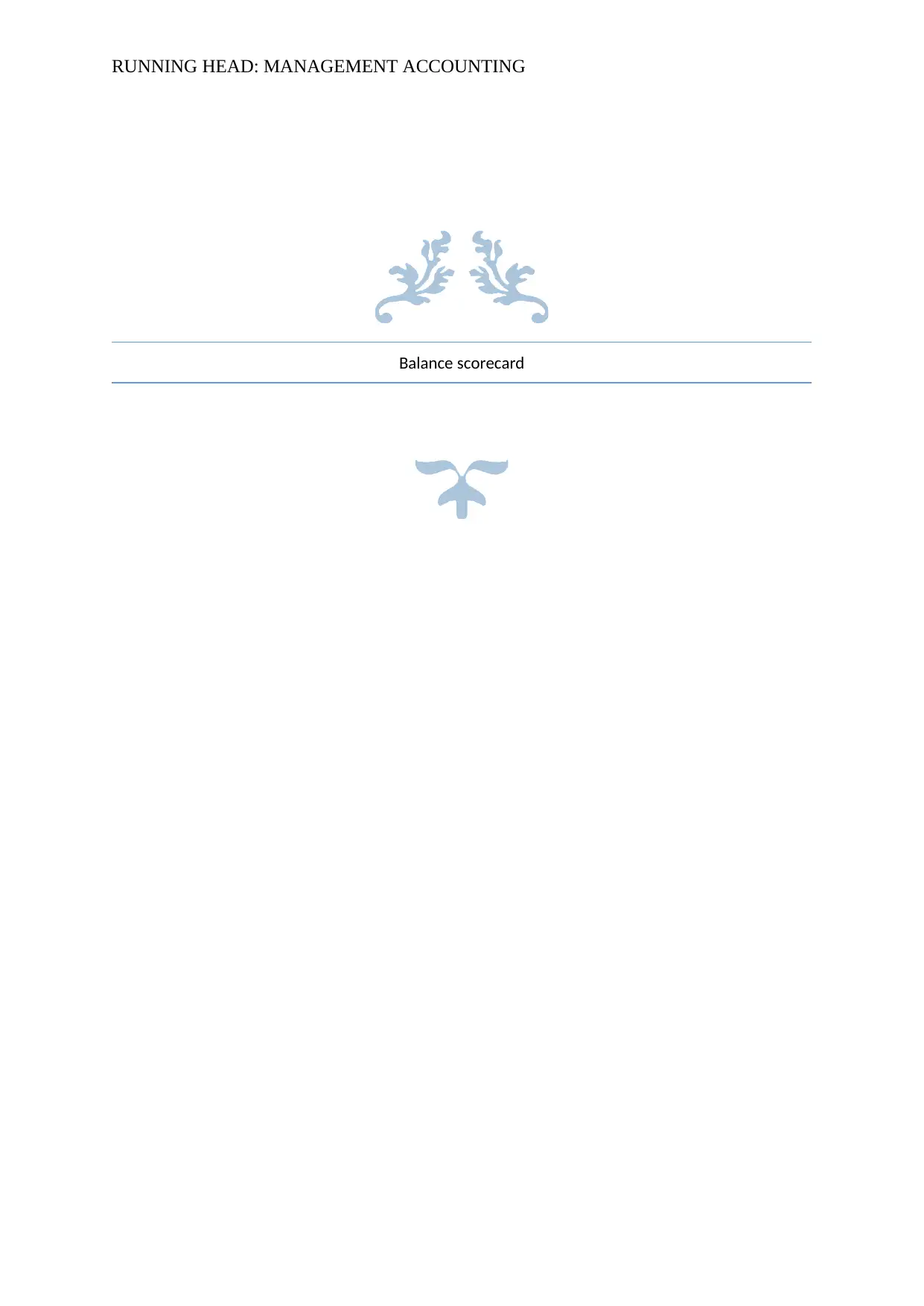
RUNNING HEAD: MANAGEMENT ACCOUNTING
Balance scorecard
Balance scorecard
Secure Best Marks with AI Grader
Need help grading? Try our AI Grader for instant feedback on your assignments.
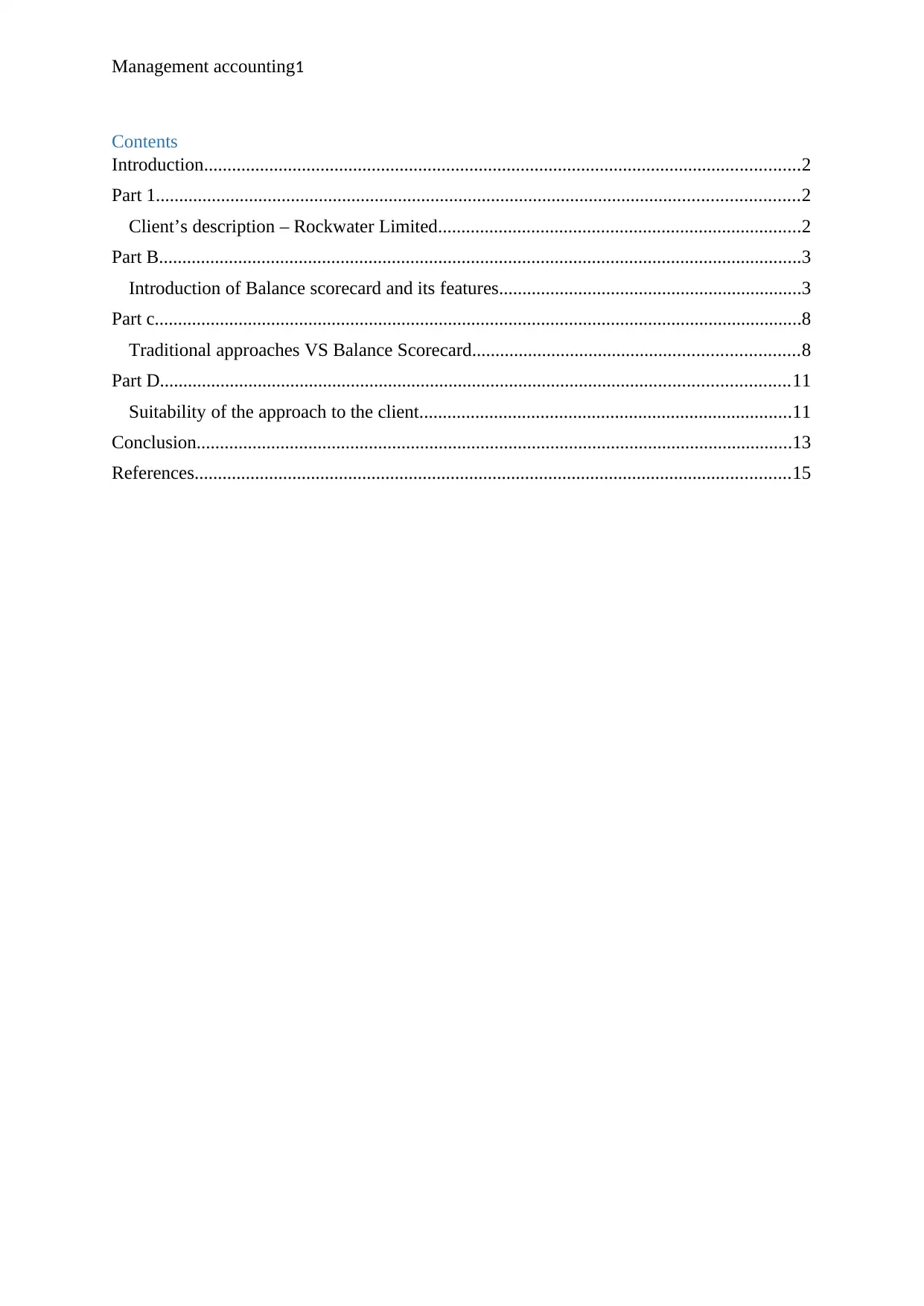
Management accounting1
Contents
Introduction................................................................................................................................2
Part 1..........................................................................................................................................2
Client’s description – Rockwater Limited..............................................................................2
Part B..........................................................................................................................................3
Introduction of Balance scorecard and its features.................................................................3
Part c...........................................................................................................................................8
Traditional approaches VS Balance Scorecard......................................................................8
Part D.......................................................................................................................................11
Suitability of the approach to the client................................................................................11
Conclusion................................................................................................................................13
References................................................................................................................................15
Contents
Introduction................................................................................................................................2
Part 1..........................................................................................................................................2
Client’s description – Rockwater Limited..............................................................................2
Part B..........................................................................................................................................3
Introduction of Balance scorecard and its features.................................................................3
Part c...........................................................................................................................................8
Traditional approaches VS Balance Scorecard......................................................................8
Part D.......................................................................................................................................11
Suitability of the approach to the client................................................................................11
Conclusion................................................................................................................................13
References................................................................................................................................15
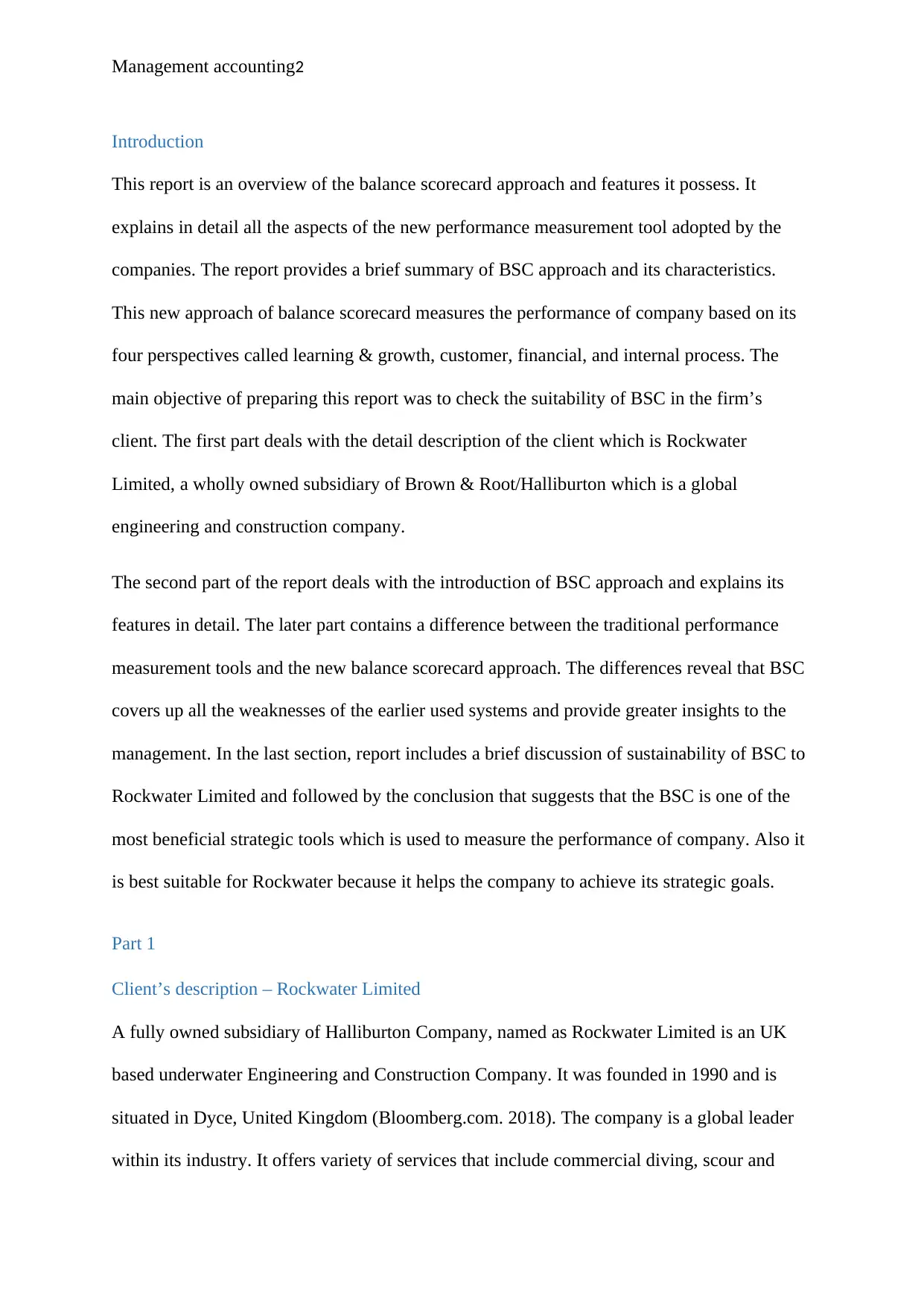
Management accounting2
Introduction
This report is an overview of the balance scorecard approach and features it possess. It
explains in detail all the aspects of the new performance measurement tool adopted by the
companies. The report provides a brief summary of BSC approach and its characteristics.
This new approach of balance scorecard measures the performance of company based on its
four perspectives called learning & growth, customer, financial, and internal process. The
main objective of preparing this report was to check the suitability of BSC in the firm’s
client. The first part deals with the detail description of the client which is Rockwater
Limited, a wholly owned subsidiary of Brown & Root/Halliburton which is a global
engineering and construction company.
The second part of the report deals with the introduction of BSC approach and explains its
features in detail. The later part contains a difference between the traditional performance
measurement tools and the new balance scorecard approach. The differences reveal that BSC
covers up all the weaknesses of the earlier used systems and provide greater insights to the
management. In the last section, report includes a brief discussion of sustainability of BSC to
Rockwater Limited and followed by the conclusion that suggests that the BSC is one of the
most beneficial strategic tools which is used to measure the performance of company. Also it
is best suitable for Rockwater because it helps the company to achieve its strategic goals.
Part 1
Client’s description – Rockwater Limited
A fully owned subsidiary of Halliburton Company, named as Rockwater Limited is an UK
based underwater Engineering and Construction Company. It was founded in 1990 and is
situated in Dyce, United Kingdom (Bloomberg.com. 2018). The company is a global leader
within its industry. It offers variety of services that include commercial diving, scour and
Introduction
This report is an overview of the balance scorecard approach and features it possess. It
explains in detail all the aspects of the new performance measurement tool adopted by the
companies. The report provides a brief summary of BSC approach and its characteristics.
This new approach of balance scorecard measures the performance of company based on its
four perspectives called learning & growth, customer, financial, and internal process. The
main objective of preparing this report was to check the suitability of BSC in the firm’s
client. The first part deals with the detail description of the client which is Rockwater
Limited, a wholly owned subsidiary of Brown & Root/Halliburton which is a global
engineering and construction company.
The second part of the report deals with the introduction of BSC approach and explains its
features in detail. The later part contains a difference between the traditional performance
measurement tools and the new balance scorecard approach. The differences reveal that BSC
covers up all the weaknesses of the earlier used systems and provide greater insights to the
management. In the last section, report includes a brief discussion of sustainability of BSC to
Rockwater Limited and followed by the conclusion that suggests that the BSC is one of the
most beneficial strategic tools which is used to measure the performance of company. Also it
is best suitable for Rockwater because it helps the company to achieve its strategic goals.
Part 1
Client’s description – Rockwater Limited
A fully owned subsidiary of Halliburton Company, named as Rockwater Limited is an UK
based underwater Engineering and Construction Company. It was founded in 1990 and is
situated in Dyce, United Kingdom (Bloomberg.com. 2018). The company is a global leader
within its industry. It offers variety of services that include commercial diving, scour and
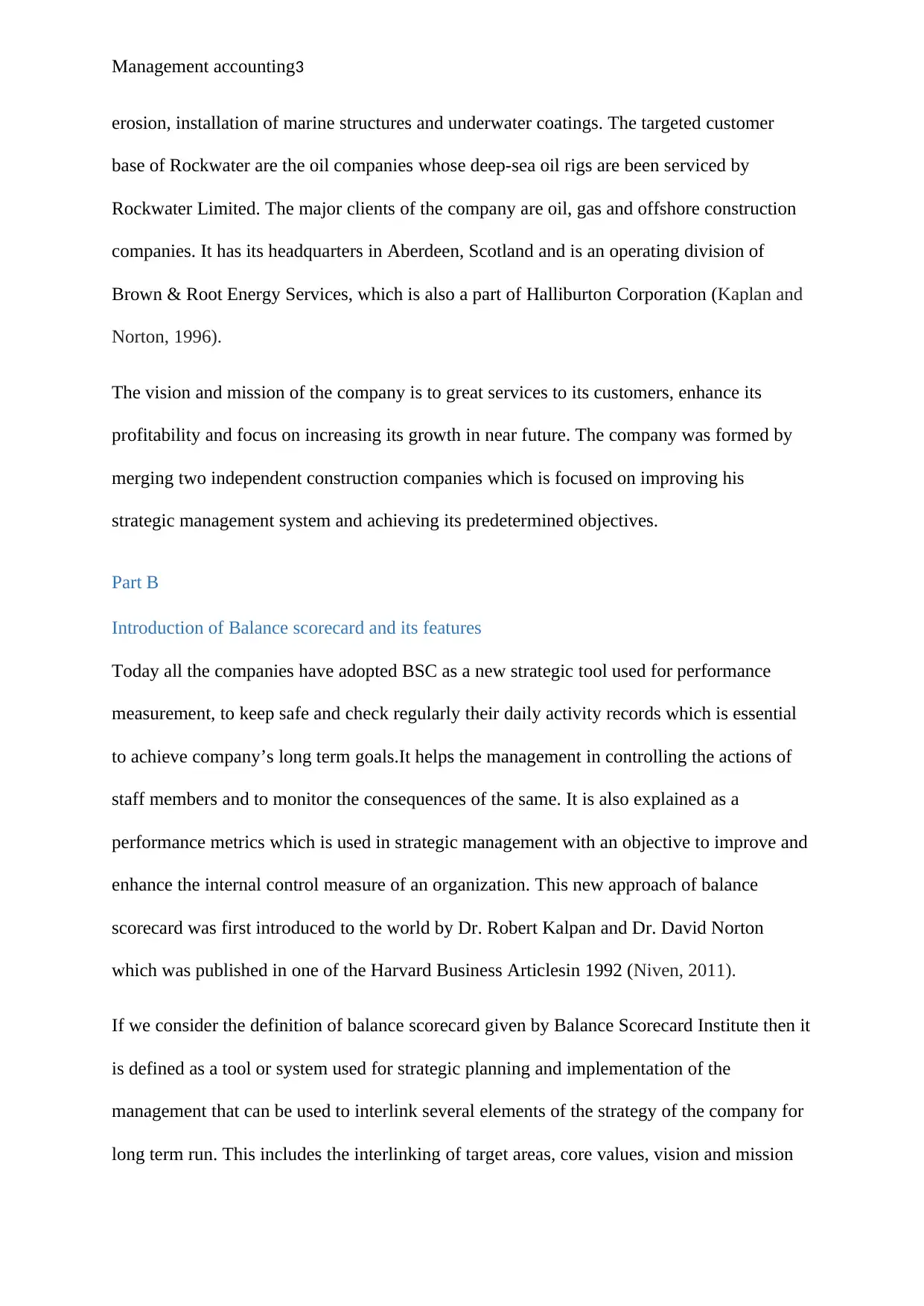
Management accounting3
erosion, installation of marine structures and underwater coatings. The targeted customer
base of Rockwater are the oil companies whose deep-sea oil rigs are been serviced by
Rockwater Limited. The major clients of the company are oil, gas and offshore construction
companies. It has its headquarters in Aberdeen, Scotland and is an operating division of
Brown & Root Energy Services, which is also a part of Halliburton Corporation (Kaplan and
Norton, 1996).
The vision and mission of the company is to great services to its customers, enhance its
profitability and focus on increasing its growth in near future. The company was formed by
merging two independent construction companies which is focused on improving his
strategic management system and achieving its predetermined objectives.
Part B
Introduction of Balance scorecard and its features
Today all the companies have adopted BSC as a new strategic tool used for performance
measurement, to keep safe and check regularly their daily activity records which is essential
to achieve company’s long term goals.It helps the management in controlling the actions of
staff members and to monitor the consequences of the same. It is also explained as a
performance metrics which is used in strategic management with an objective to improve and
enhance the internal control measure of an organization. This new approach of balance
scorecard was first introduced to the world by Dr. Robert Kalpan and Dr. David Norton
which was published in one of the Harvard Business Articlesin 1992 (Niven, 2011).
If we consider the definition of balance scorecard given by Balance Scorecard Institute then it
is defined as a tool or system used for strategic planning and implementation of the
management that can be used to interlink several elements of the strategy of the company for
long term run. This includes the interlinking of target areas, core values, vision and mission
erosion, installation of marine structures and underwater coatings. The targeted customer
base of Rockwater are the oil companies whose deep-sea oil rigs are been serviced by
Rockwater Limited. The major clients of the company are oil, gas and offshore construction
companies. It has its headquarters in Aberdeen, Scotland and is an operating division of
Brown & Root Energy Services, which is also a part of Halliburton Corporation (Kaplan and
Norton, 1996).
The vision and mission of the company is to great services to its customers, enhance its
profitability and focus on increasing its growth in near future. The company was formed by
merging two independent construction companies which is focused on improving his
strategic management system and achieving its predetermined objectives.
Part B
Introduction of Balance scorecard and its features
Today all the companies have adopted BSC as a new strategic tool used for performance
measurement, to keep safe and check regularly their daily activity records which is essential
to achieve company’s long term goals.It helps the management in controlling the actions of
staff members and to monitor the consequences of the same. It is also explained as a
performance metrics which is used in strategic management with an objective to improve and
enhance the internal control measure of an organization. This new approach of balance
scorecard was first introduced to the world by Dr. Robert Kalpan and Dr. David Norton
which was published in one of the Harvard Business Articlesin 1992 (Niven, 2011).
If we consider the definition of balance scorecard given by Balance Scorecard Institute then it
is defined as a tool or system used for strategic planning and implementation of the
management that can be used to interlink several elements of the strategy of the company for
long term run. This includes the interlinking of target areas, core values, vision and mission
Secure Best Marks with AI Grader
Need help grading? Try our AI Grader for instant feedback on your assignments.
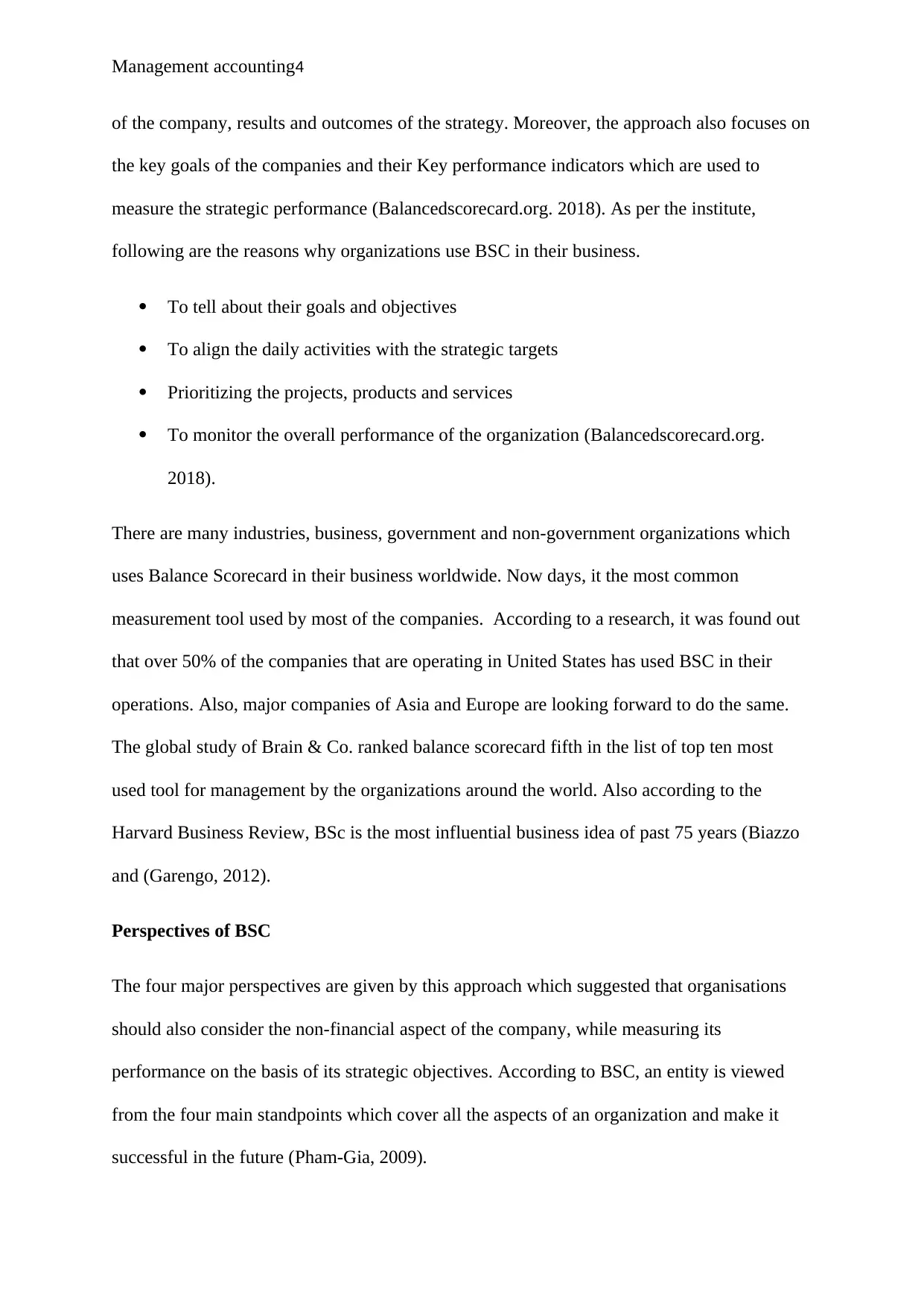
Management accounting4
of the company, results and outcomes of the strategy. Moreover, the approach also focuses on
the key goals of the companies and their Key performance indicators which are used to
measure the strategic performance (Balancedscorecard.org. 2018). As per the institute,
following are the reasons why organizations use BSC in their business.
To tell about their goals and objectives
To align the daily activities with the strategic targets
Prioritizing the projects, products and services
To monitor the overall performance of the organization (Balancedscorecard.org.
2018).
There are many industries, business, government and non-government organizations which
uses Balance Scorecard in their business worldwide. Now days, it the most common
measurement tool used by most of the companies. According to a research, it was found out
that over 50% of the companies that are operating in United States has used BSC in their
operations. Also, major companies of Asia and Europe are looking forward to do the same.
The global study of Brain & Co. ranked balance scorecard fifth in the list of top ten most
used tool for management by the organizations around the world. Also according to the
Harvard Business Review, BSc is the most influential business idea of past 75 years (Biazzo
and (Garengo, 2012).
Perspectives of BSC
The four major perspectives are given by this approach which suggested that organisations
should also consider the non-financial aspect of the company, while measuring its
performance on the basis of its strategic objectives. According to BSC, an entity is viewed
from the four main standpoints which cover all the aspects of an organization and make it
successful in the future (Pham-Gia, 2009).
of the company, results and outcomes of the strategy. Moreover, the approach also focuses on
the key goals of the companies and their Key performance indicators which are used to
measure the strategic performance (Balancedscorecard.org. 2018). As per the institute,
following are the reasons why organizations use BSC in their business.
To tell about their goals and objectives
To align the daily activities with the strategic targets
Prioritizing the projects, products and services
To monitor the overall performance of the organization (Balancedscorecard.org.
2018).
There are many industries, business, government and non-government organizations which
uses Balance Scorecard in their business worldwide. Now days, it the most common
measurement tool used by most of the companies. According to a research, it was found out
that over 50% of the companies that are operating in United States has used BSC in their
operations. Also, major companies of Asia and Europe are looking forward to do the same.
The global study of Brain & Co. ranked balance scorecard fifth in the list of top ten most
used tool for management by the organizations around the world. Also according to the
Harvard Business Review, BSc is the most influential business idea of past 75 years (Biazzo
and (Garengo, 2012).
Perspectives of BSC
The four major perspectives are given by this approach which suggested that organisations
should also consider the non-financial aspect of the company, while measuring its
performance on the basis of its strategic objectives. According to BSC, an entity is viewed
from the four main standpoints which cover all the aspects of an organization and make it
successful in the future (Pham-Gia, 2009).
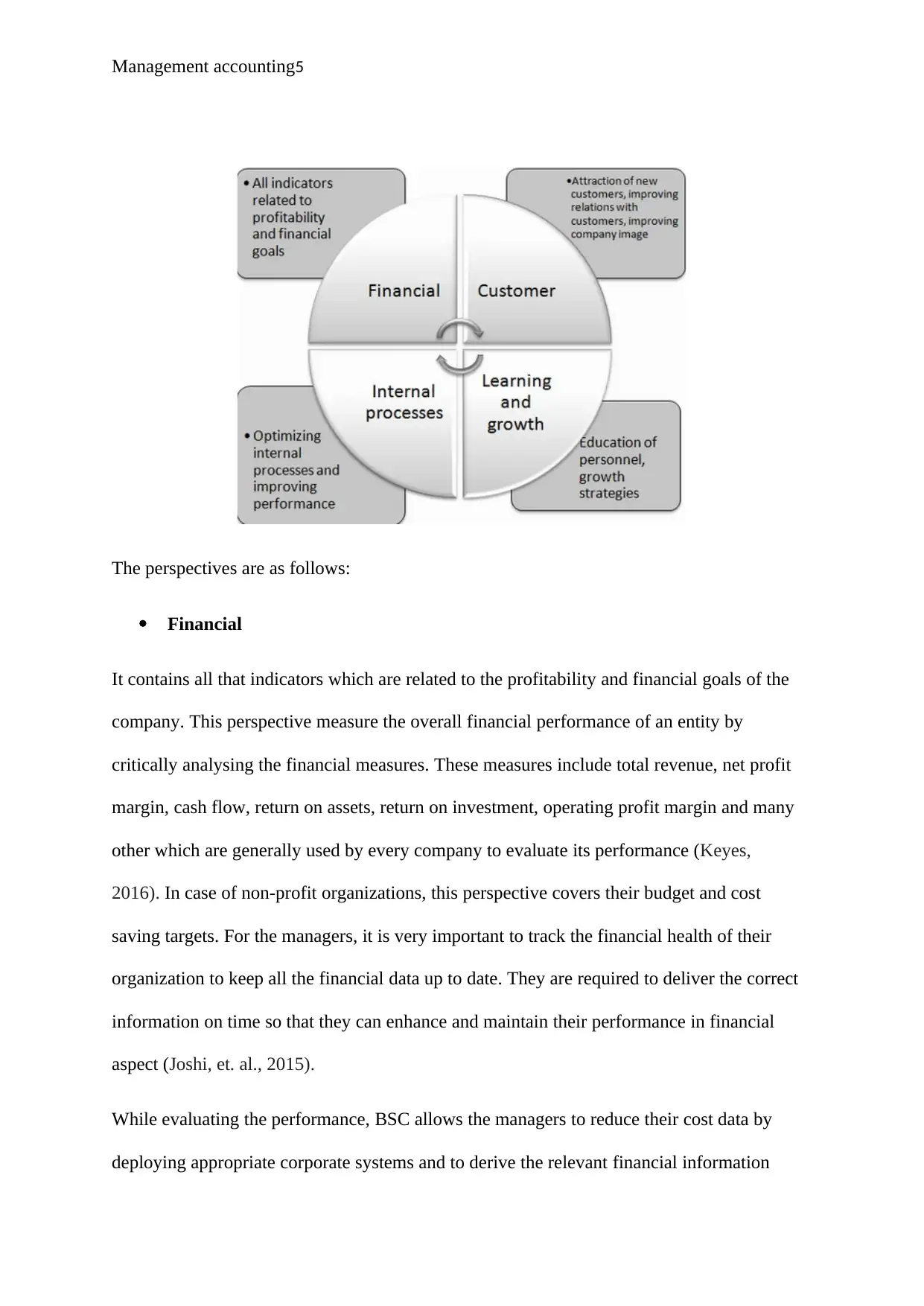
Management accounting5
The perspectives are as follows:
Financial
It contains all that indicators which are related to the profitability and financial goals of the
company. This perspective measure the overall financial performance of an entity by
critically analysing the financial measures. These measures include total revenue, net profit
margin, cash flow, return on assets, return on investment, operating profit margin and many
other which are generally used by every company to evaluate its performance (Keyes,
2016). In case of non-profit organizations, this perspective covers their budget and cost
saving targets. For the managers, it is very important to track the financial health of their
organization to keep all the financial data up to date. They are required to deliver the correct
information on time so that they can enhance and maintain their performance in financial
aspect (Joshi, et. al., 2015).
While evaluating the performance, BSC allows the managers to reduce their cost data by
deploying appropriate corporate systems and to derive the relevant financial information
The perspectives are as follows:
Financial
It contains all that indicators which are related to the profitability and financial goals of the
company. This perspective measure the overall financial performance of an entity by
critically analysing the financial measures. These measures include total revenue, net profit
margin, cash flow, return on assets, return on investment, operating profit margin and many
other which are generally used by every company to evaluate its performance (Keyes,
2016). In case of non-profit organizations, this perspective covers their budget and cost
saving targets. For the managers, it is very important to track the financial health of their
organization to keep all the financial data up to date. They are required to deliver the correct
information on time so that they can enhance and maintain their performance in financial
aspect (Joshi, et. al., 2015).
While evaluating the performance, BSC allows the managers to reduce their cost data by
deploying appropriate corporate systems and to derive the relevant financial information
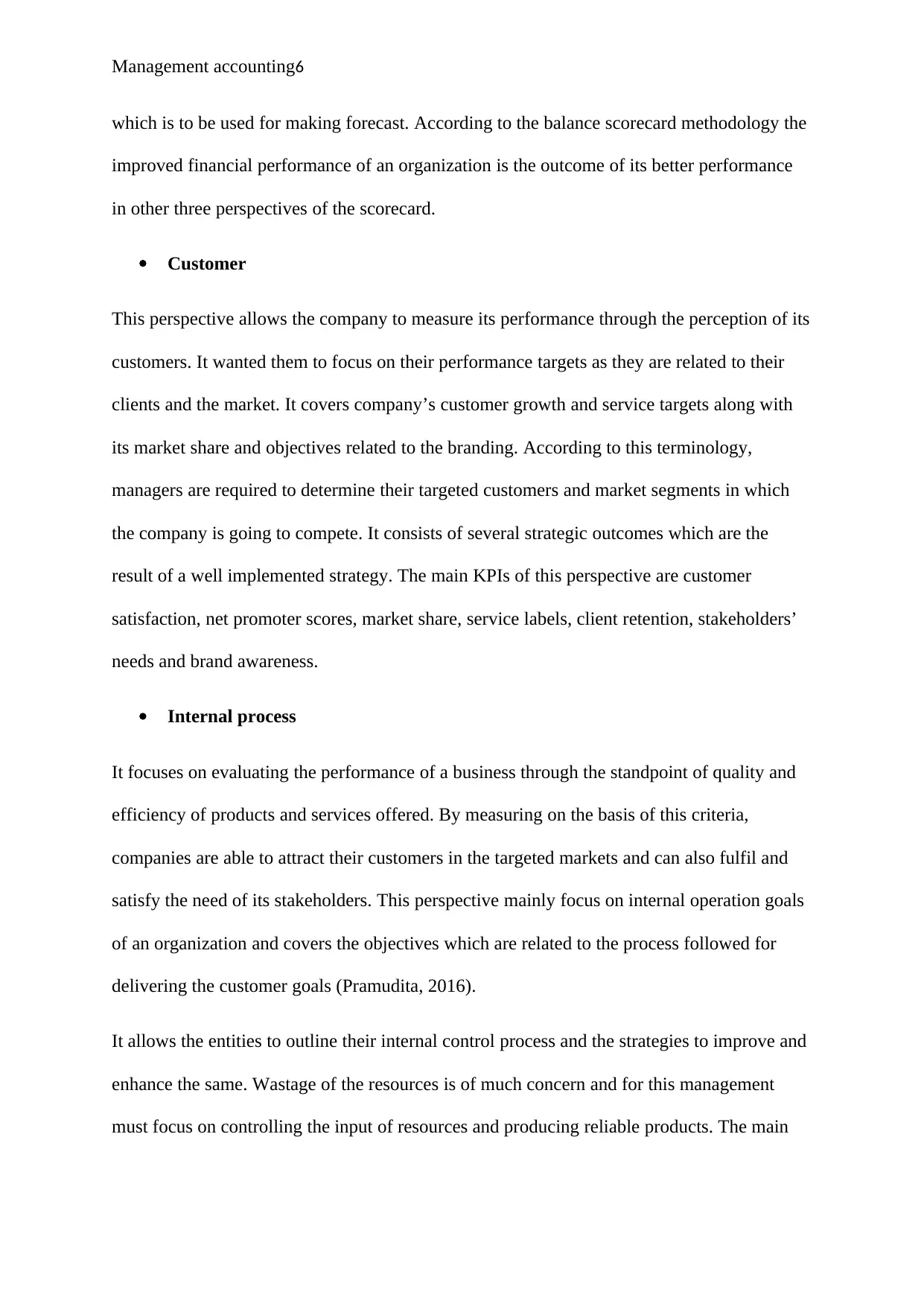
Management accounting6
which is to be used for making forecast. According to the balance scorecard methodology the
improved financial performance of an organization is the outcome of its better performance
in other three perspectives of the scorecard.
Customer
This perspective allows the company to measure its performance through the perception of its
customers. It wanted them to focus on their performance targets as they are related to their
clients and the market. It covers company’s customer growth and service targets along with
its market share and objectives related to the branding. According to this terminology,
managers are required to determine their targeted customers and market segments in which
the company is going to compete. It consists of several strategic outcomes which are the
result of a well implemented strategy. The main KPIs of this perspective are customer
satisfaction, net promoter scores, market share, service labels, client retention, stakeholders’
needs and brand awareness.
Internal process
It focuses on evaluating the performance of a business through the standpoint of quality and
efficiency of products and services offered. By measuring on the basis of this criteria,
companies are able to attract their customers in the targeted markets and can also fulfil and
satisfy the need of its stakeholders. This perspective mainly focus on internal operation goals
of an organization and covers the objectives which are related to the process followed for
delivering the customer goals (Pramudita, 2016).
It allows the entities to outline their internal control process and the strategies to improve and
enhance the same. Wastage of the resources is of much concern and for this management
must focus on controlling the input of resources and producing reliable products. The main
which is to be used for making forecast. According to the balance scorecard methodology the
improved financial performance of an organization is the outcome of its better performance
in other three perspectives of the scorecard.
Customer
This perspective allows the company to measure its performance through the perception of its
customers. It wanted them to focus on their performance targets as they are related to their
clients and the market. It covers company’s customer growth and service targets along with
its market share and objectives related to the branding. According to this terminology,
managers are required to determine their targeted customers and market segments in which
the company is going to compete. It consists of several strategic outcomes which are the
result of a well implemented strategy. The main KPIs of this perspective are customer
satisfaction, net promoter scores, market share, service labels, client retention, stakeholders’
needs and brand awareness.
Internal process
It focuses on evaluating the performance of a business through the standpoint of quality and
efficiency of products and services offered. By measuring on the basis of this criteria,
companies are able to attract their customers in the targeted markets and can also fulfil and
satisfy the need of its stakeholders. This perspective mainly focus on internal operation goals
of an organization and covers the objectives which are related to the process followed for
delivering the customer goals (Pramudita, 2016).
It allows the entities to outline their internal control process and the strategies to improve and
enhance the same. Wastage of the resources is of much concern and for this management
must focus on controlling the input of resources and producing reliable products. The main
Paraphrase This Document
Need a fresh take? Get an instant paraphrase of this document with our AI Paraphraser
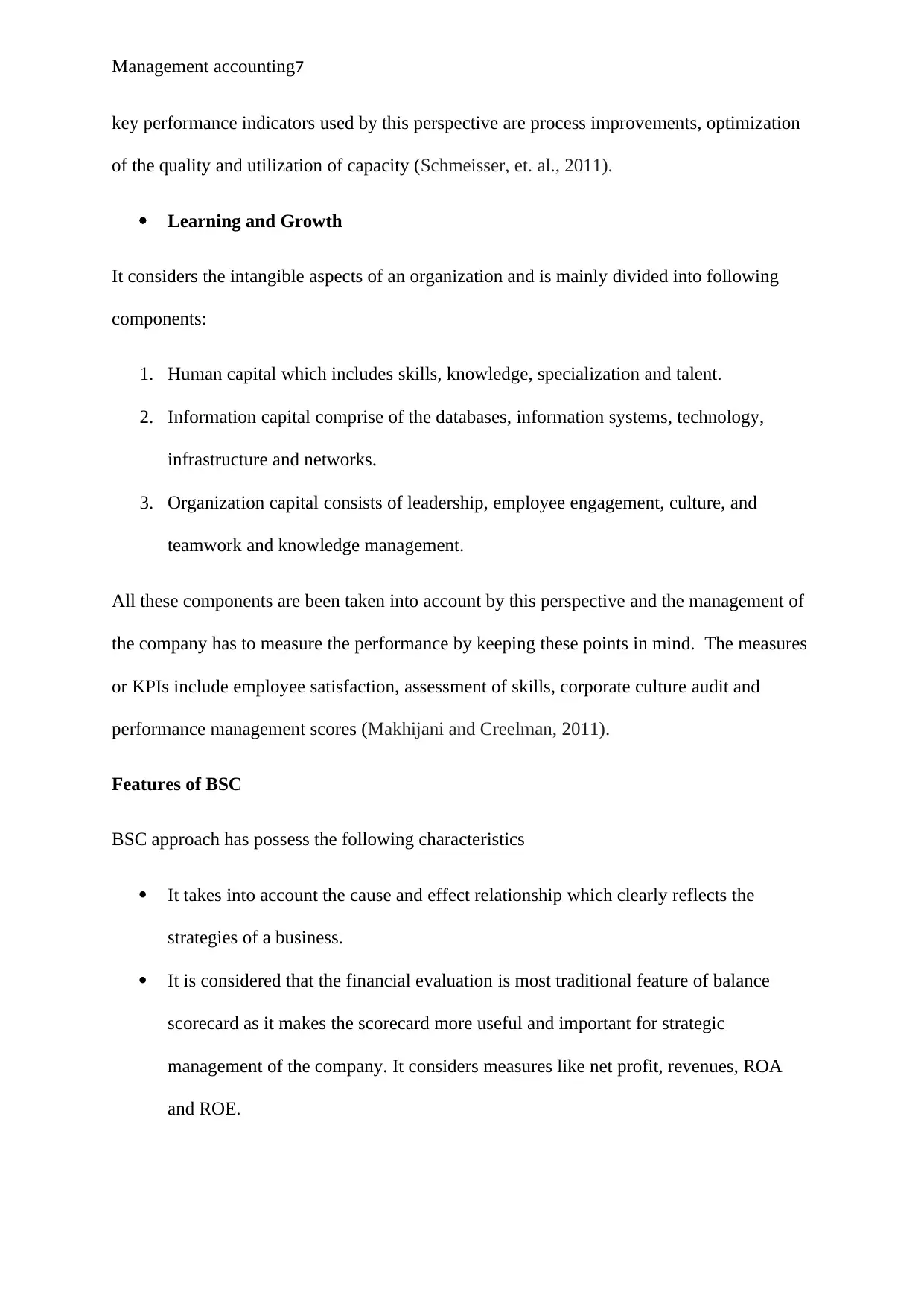
Management accounting7
key performance indicators used by this perspective are process improvements, optimization
of the quality and utilization of capacity (Schmeisser, et. al., 2011).
Learning and Growth
It considers the intangible aspects of an organization and is mainly divided into following
components:
1. Human capital which includes skills, knowledge, specialization and talent.
2. Information capital comprise of the databases, information systems, technology,
infrastructure and networks.
3. Organization capital consists of leadership, employee engagement, culture, and
teamwork and knowledge management.
All these components are been taken into account by this perspective and the management of
the company has to measure the performance by keeping these points in mind. The measures
or KPIs include employee satisfaction, assessment of skills, corporate culture audit and
performance management scores (Makhijani and Creelman, 2011).
Features of BSC
BSC approach has possess the following characteristics
It takes into account the cause and effect relationship which clearly reflects the
strategies of a business.
It is considered that the financial evaluation is most traditional feature of balance
scorecard as it makes the scorecard more useful and important for strategic
management of the company. It considers measures like net profit, revenues, ROA
and ROE.
key performance indicators used by this perspective are process improvements, optimization
of the quality and utilization of capacity (Schmeisser, et. al., 2011).
Learning and Growth
It considers the intangible aspects of an organization and is mainly divided into following
components:
1. Human capital which includes skills, knowledge, specialization and talent.
2. Information capital comprise of the databases, information systems, technology,
infrastructure and networks.
3. Organization capital consists of leadership, employee engagement, culture, and
teamwork and knowledge management.
All these components are been taken into account by this perspective and the management of
the company has to measure the performance by keeping these points in mind. The measures
or KPIs include employee satisfaction, assessment of skills, corporate culture audit and
performance management scores (Makhijani and Creelman, 2011).
Features of BSC
BSC approach has possess the following characteristics
It takes into account the cause and effect relationship which clearly reflects the
strategies of a business.
It is considered that the financial evaluation is most traditional feature of balance
scorecard as it makes the scorecard more useful and important for strategic
management of the company. It considers measures like net profit, revenues, ROA
and ROE.
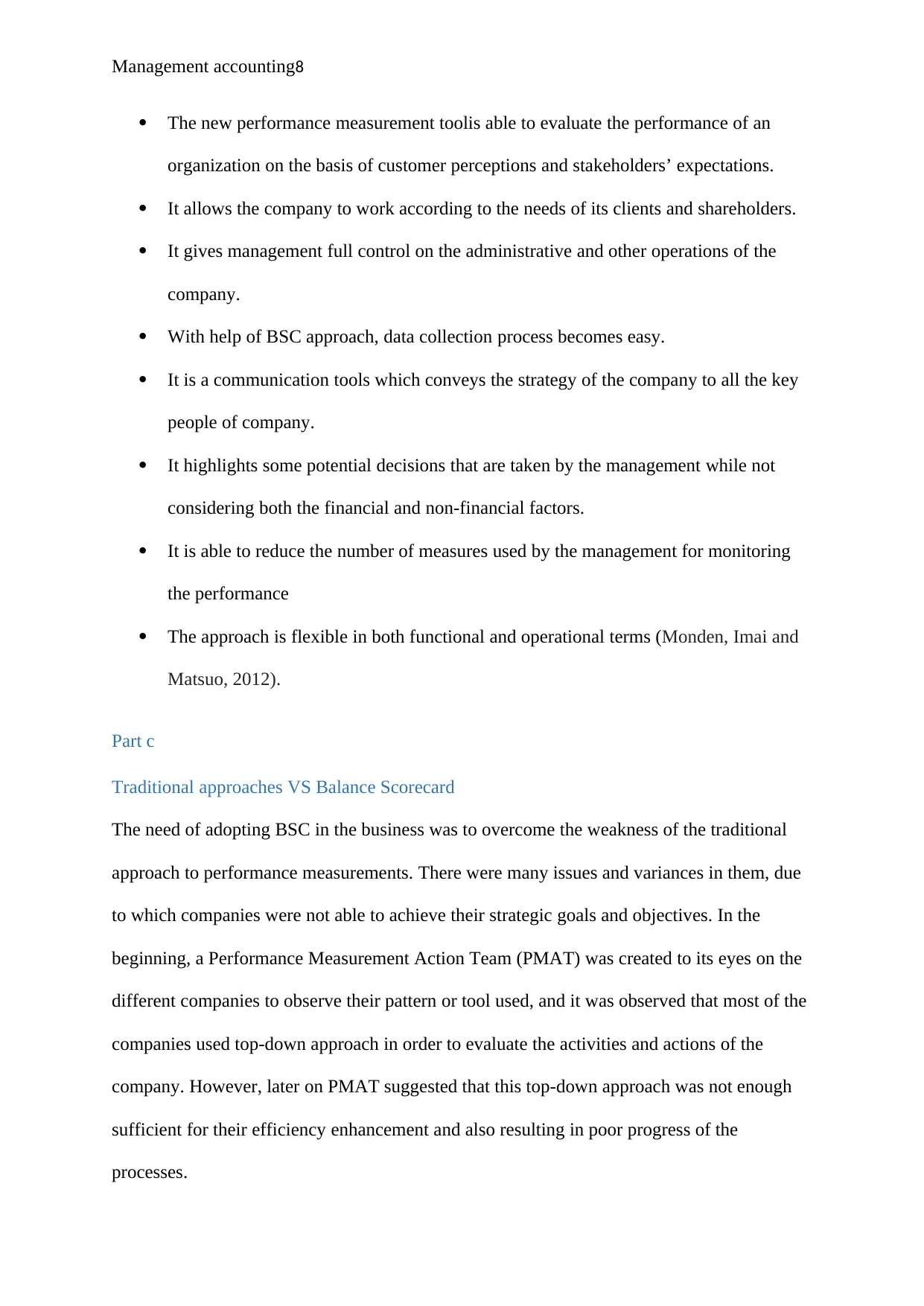
Management accounting8
The new performance measurement toolis able to evaluate the performance of an
organization on the basis of customer perceptions and stakeholders’ expectations.
It allows the company to work according to the needs of its clients and shareholders.
It gives management full control on the administrative and other operations of the
company.
With help of BSC approach, data collection process becomes easy.
It is a communication tools which conveys the strategy of the company to all the key
people of company.
It highlights some potential decisions that are taken by the management while not
considering both the financial and non-financial factors.
It is able to reduce the number of measures used by the management for monitoring
the performance
The approach is flexible in both functional and operational terms (Monden, Imai and
Matsuo, 2012).
Part c
Traditional approaches VS Balance Scorecard
The need of adopting BSC in the business was to overcome the weakness of the traditional
approach to performance measurements. There were many issues and variances in them, due
to which companies were not able to achieve their strategic goals and objectives. In the
beginning, a Performance Measurement Action Team (PMAT) was created to its eyes on the
different companies to observe their pattern or tool used, and it was observed that most of the
companies used top-down approach in order to evaluate the activities and actions of the
company. However, later on PMAT suggested that this top-down approach was not enough
sufficient for their efficiency enhancement and also resulting in poor progress of the
processes.
The new performance measurement toolis able to evaluate the performance of an
organization on the basis of customer perceptions and stakeholders’ expectations.
It allows the company to work according to the needs of its clients and shareholders.
It gives management full control on the administrative and other operations of the
company.
With help of BSC approach, data collection process becomes easy.
It is a communication tools which conveys the strategy of the company to all the key
people of company.
It highlights some potential decisions that are taken by the management while not
considering both the financial and non-financial factors.
It is able to reduce the number of measures used by the management for monitoring
the performance
The approach is flexible in both functional and operational terms (Monden, Imai and
Matsuo, 2012).
Part c
Traditional approaches VS Balance Scorecard
The need of adopting BSC in the business was to overcome the weakness of the traditional
approach to performance measurements. There were many issues and variances in them, due
to which companies were not able to achieve their strategic goals and objectives. In the
beginning, a Performance Measurement Action Team (PMAT) was created to its eyes on the
different companies to observe their pattern or tool used, and it was observed that most of the
companies used top-down approach in order to evaluate the activities and actions of the
company. However, later on PMAT suggested that this top-down approach was not enough
sufficient for their efficiency enhancement and also resulting in poor progress of the
processes.
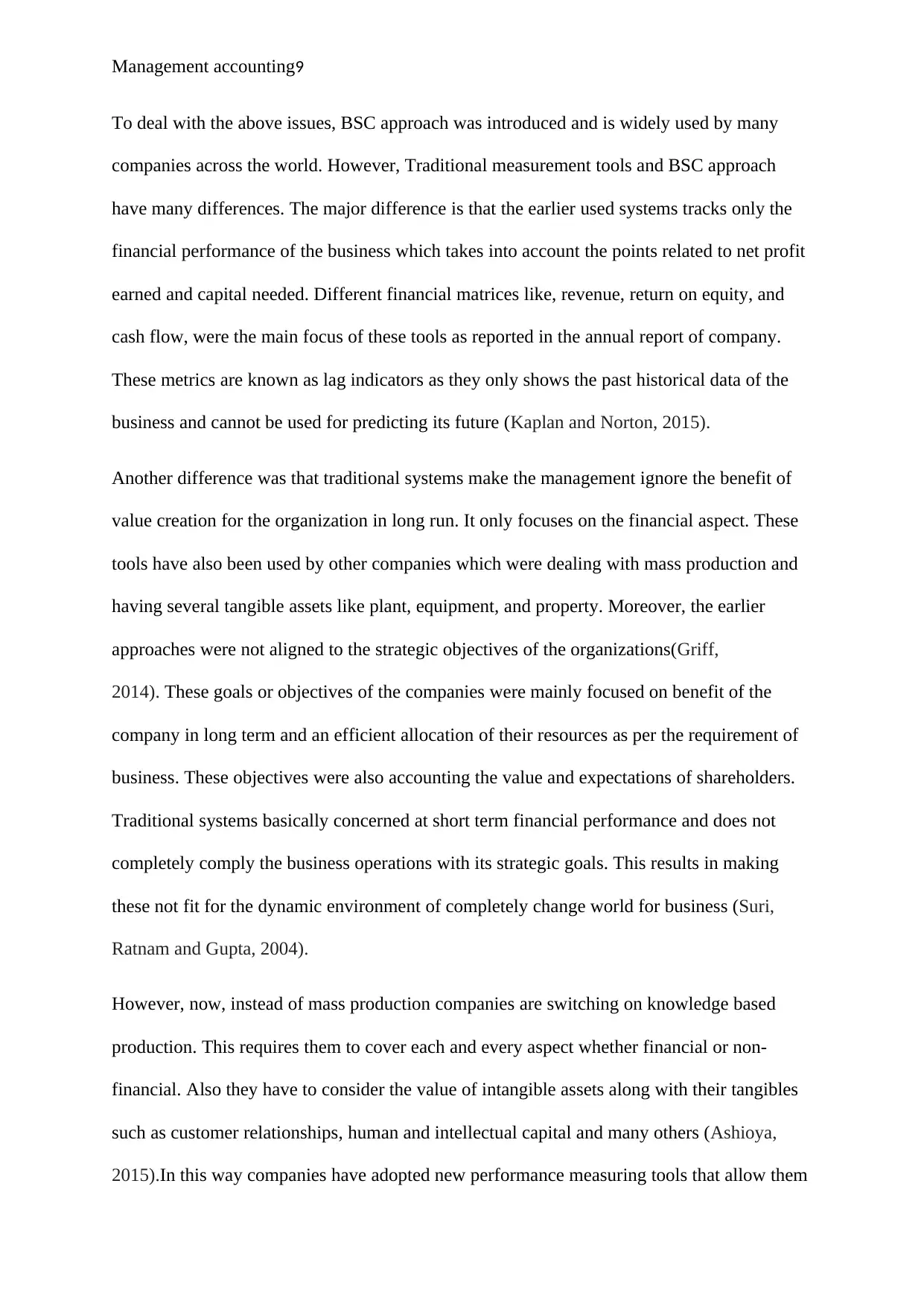
Management accounting9
To deal with the above issues, BSC approach was introduced and is widely used by many
companies across the world. However, Traditional measurement tools and BSC approach
have many differences. The major difference is that the earlier used systems tracks only the
financial performance of the business which takes into account the points related to net profit
earned and capital needed. Different financial matrices like, revenue, return on equity, and
cash flow, were the main focus of these tools as reported in the annual report of company.
These metrics are known as lag indicators as they only shows the past historical data of the
business and cannot be used for predicting its future (Kaplan and Norton, 2015).
Another difference was that traditional systems make the management ignore the benefit of
value creation for the organization in long run. It only focuses on the financial aspect. These
tools have also been used by other companies which were dealing with mass production and
having several tangible assets like plant, equipment, and property. Moreover, the earlier
approaches were not aligned to the strategic objectives of the organizations(Griff,
2014). These goals or objectives of the companies were mainly focused on benefit of the
company in long term and an efficient allocation of their resources as per the requirement of
business. These objectives were also accounting the value and expectations of shareholders.
Traditional systems basically concerned at short term financial performance and does not
completely comply the business operations with its strategic goals. This results in making
these not fit for the dynamic environment of completely change world for business (Suri,
Ratnam and Gupta, 2004).
However, now, instead of mass production companies are switching on knowledge based
production. This requires them to cover each and every aspect whether financial or non-
financial. Also they have to consider the value of intangible assets along with their tangibles
such as customer relationships, human and intellectual capital and many others (Ashioya,
2015).In this way companies have adopted new performance measuring tools that allow them
To deal with the above issues, BSC approach was introduced and is widely used by many
companies across the world. However, Traditional measurement tools and BSC approach
have many differences. The major difference is that the earlier used systems tracks only the
financial performance of the business which takes into account the points related to net profit
earned and capital needed. Different financial matrices like, revenue, return on equity, and
cash flow, were the main focus of these tools as reported in the annual report of company.
These metrics are known as lag indicators as they only shows the past historical data of the
business and cannot be used for predicting its future (Kaplan and Norton, 2015).
Another difference was that traditional systems make the management ignore the benefit of
value creation for the organization in long run. It only focuses on the financial aspect. These
tools have also been used by other companies which were dealing with mass production and
having several tangible assets like plant, equipment, and property. Moreover, the earlier
approaches were not aligned to the strategic objectives of the organizations(Griff,
2014). These goals or objectives of the companies were mainly focused on benefit of the
company in long term and an efficient allocation of their resources as per the requirement of
business. These objectives were also accounting the value and expectations of shareholders.
Traditional systems basically concerned at short term financial performance and does not
completely comply the business operations with its strategic goals. This results in making
these not fit for the dynamic environment of completely change world for business (Suri,
Ratnam and Gupta, 2004).
However, now, instead of mass production companies are switching on knowledge based
production. This requires them to cover each and every aspect whether financial or non-
financial. Also they have to consider the value of intangible assets along with their tangibles
such as customer relationships, human and intellectual capital and many others (Ashioya,
2015).In this way companies have adopted new performance measuring tools that allow them
Secure Best Marks with AI Grader
Need help grading? Try our AI Grader for instant feedback on your assignments.
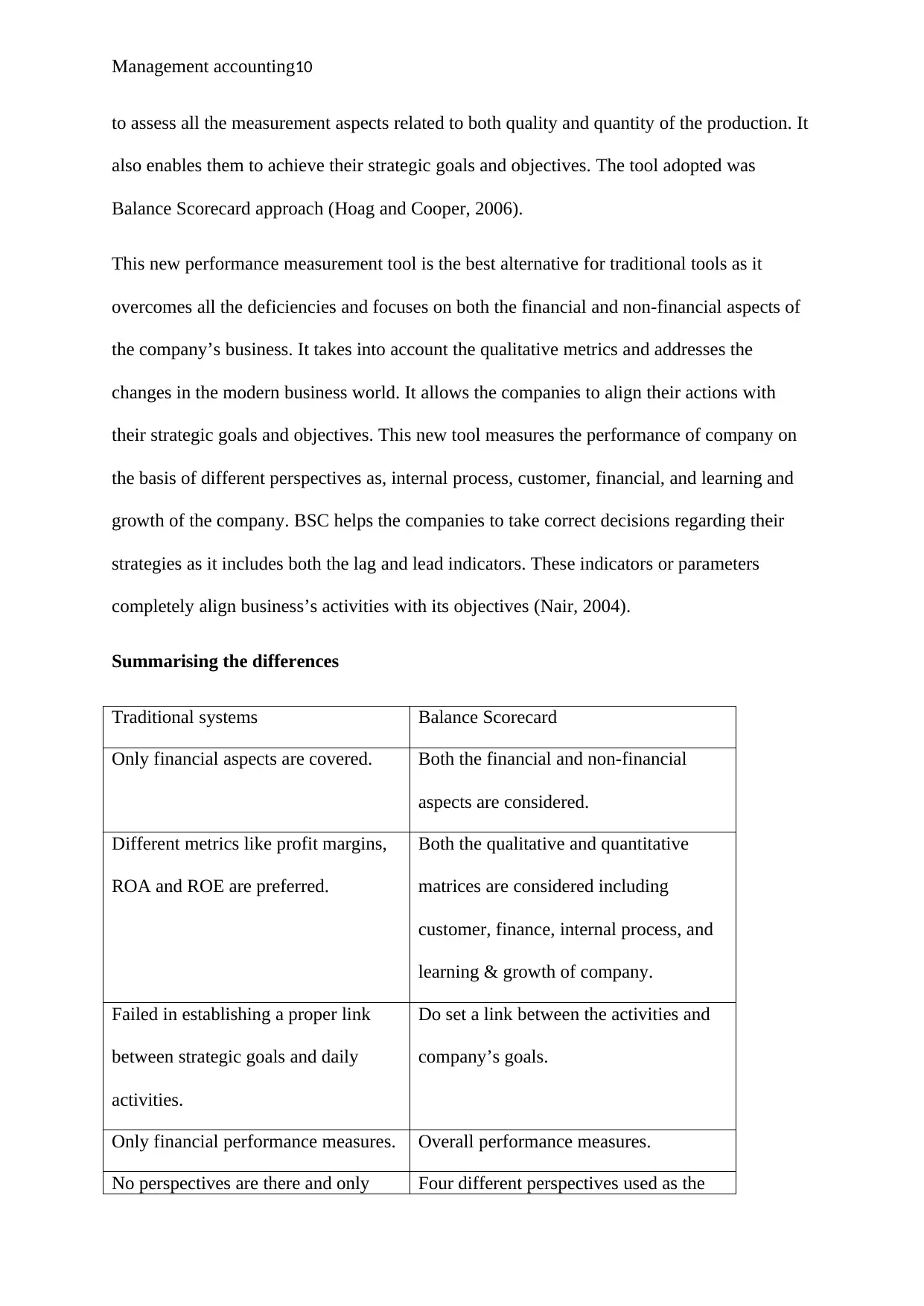
Management accounting10
to assess all the measurement aspects related to both quality and quantity of the production. It
also enables them to achieve their strategic goals and objectives. The tool adopted was
Balance Scorecard approach (Hoag and Cooper, 2006).
This new performance measurement tool is the best alternative for traditional tools as it
overcomes all the deficiencies and focuses on both the financial and non-financial aspects of
the company’s business. It takes into account the qualitative metrics and addresses the
changes in the modern business world. It allows the companies to align their actions with
their strategic goals and objectives. This new tool measures the performance of company on
the basis of different perspectives as, internal process, customer, financial, and learning and
growth of the company. BSC helps the companies to take correct decisions regarding their
strategies as it includes both the lag and lead indicators. These indicators or parameters
completely align business’s activities with its objectives (Nair, 2004).
Summarising the differences
Traditional systems Balance Scorecard
Only financial aspects are covered. Both the financial and non-financial
aspects are considered.
Different metrics like profit margins,
ROA and ROE are preferred.
Both the qualitative and quantitative
matrices are considered including
customer, finance, internal process, and
learning & growth of company.
Failed in establishing a proper link
between strategic goals and daily
activities.
Do set a link between the activities and
company’s goals.
Only financial performance measures. Overall performance measures.
No perspectives are there and only Four different perspectives used as the
to assess all the measurement aspects related to both quality and quantity of the production. It
also enables them to achieve their strategic goals and objectives. The tool adopted was
Balance Scorecard approach (Hoag and Cooper, 2006).
This new performance measurement tool is the best alternative for traditional tools as it
overcomes all the deficiencies and focuses on both the financial and non-financial aspects of
the company’s business. It takes into account the qualitative metrics and addresses the
changes in the modern business world. It allows the companies to align their actions with
their strategic goals and objectives. This new tool measures the performance of company on
the basis of different perspectives as, internal process, customer, financial, and learning and
growth of the company. BSC helps the companies to take correct decisions regarding their
strategies as it includes both the lag and lead indicators. These indicators or parameters
completely align business’s activities with its objectives (Nair, 2004).
Summarising the differences
Traditional systems Balance Scorecard
Only financial aspects are covered. Both the financial and non-financial
aspects are considered.
Different metrics like profit margins,
ROA and ROE are preferred.
Both the qualitative and quantitative
matrices are considered including
customer, finance, internal process, and
learning & growth of company.
Failed in establishing a proper link
between strategic goals and daily
activities.
Do set a link between the activities and
company’s goals.
Only financial performance measures. Overall performance measures.
No perspectives are there and only Four different perspectives used as the
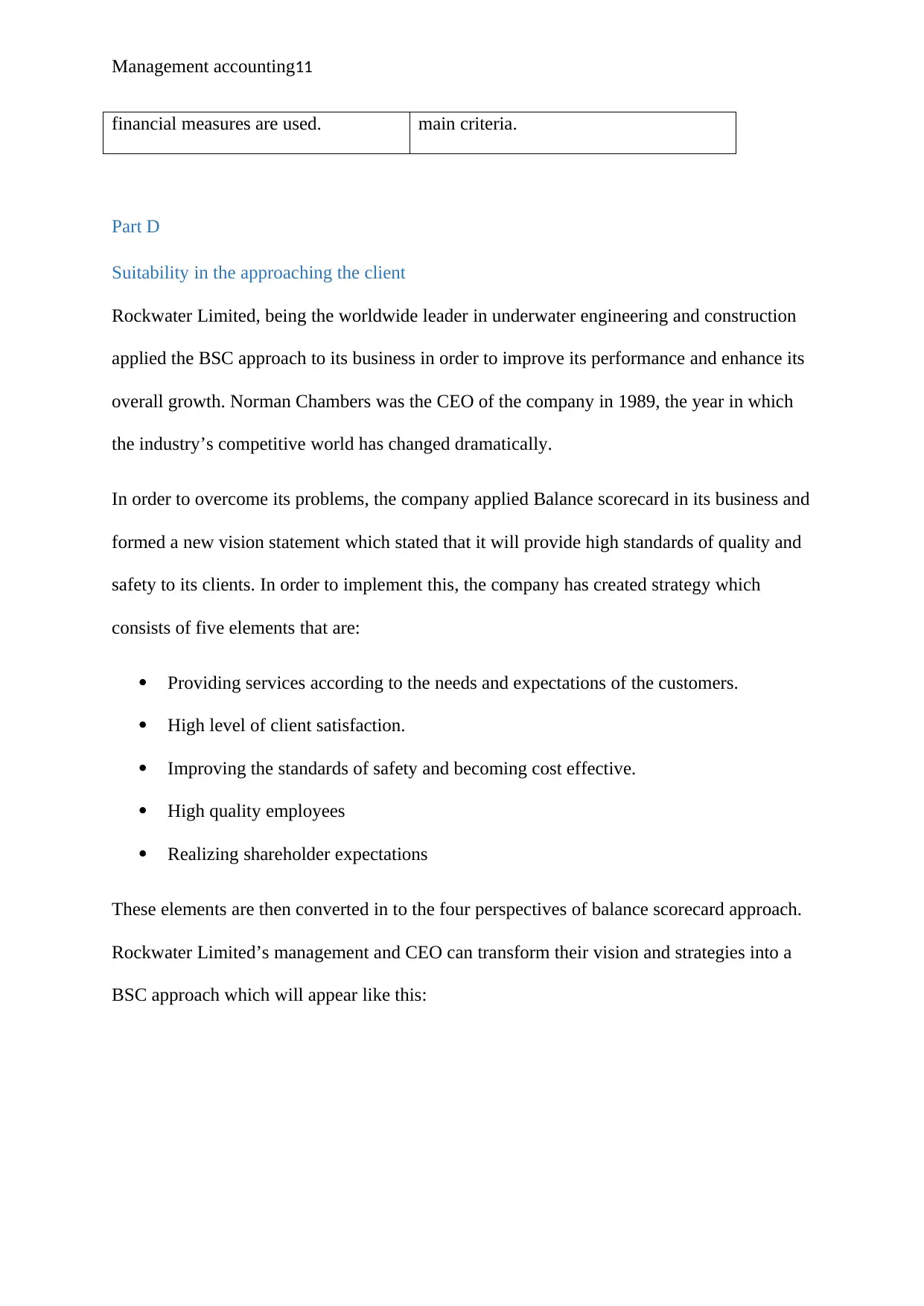
Management accounting11
financial measures are used. main criteria.
Part D
Suitability in the approaching the client
Rockwater Limited, being the worldwide leader in underwater engineering and construction
applied the BSC approach to its business in order to improve its performance and enhance its
overall growth. Norman Chambers was the CEO of the company in 1989, the year in which
the industry’s competitive world has changed dramatically.
In order to overcome its problems, the company applied Balance scorecard in its business and
formed a new vision statement which stated that it will provide high standards of quality and
safety to its clients. In order to implement this, the company has created strategy which
consists of five elements that are:
Providing services according to the needs and expectations of the customers.
High level of client satisfaction.
Improving the standards of safety and becoming cost effective.
High quality employees
Realizing shareholder expectations
These elements are then converted in to the four perspectives of balance scorecard approach.
Rockwater Limited’s management and CEO can transform their vision and strategies into a
BSC approach which will appear like this:
financial measures are used. main criteria.
Part D
Suitability in the approaching the client
Rockwater Limited, being the worldwide leader in underwater engineering and construction
applied the BSC approach to its business in order to improve its performance and enhance its
overall growth. Norman Chambers was the CEO of the company in 1989, the year in which
the industry’s competitive world has changed dramatically.
In order to overcome its problems, the company applied Balance scorecard in its business and
formed a new vision statement which stated that it will provide high standards of quality and
safety to its clients. In order to implement this, the company has created strategy which
consists of five elements that are:
Providing services according to the needs and expectations of the customers.
High level of client satisfaction.
Improving the standards of safety and becoming cost effective.
High quality employees
Realizing shareholder expectations
These elements are then converted in to the four perspectives of balance scorecard approach.
Rockwater Limited’s management and CEO can transform their vision and strategies into a
BSC approach which will appear like this:
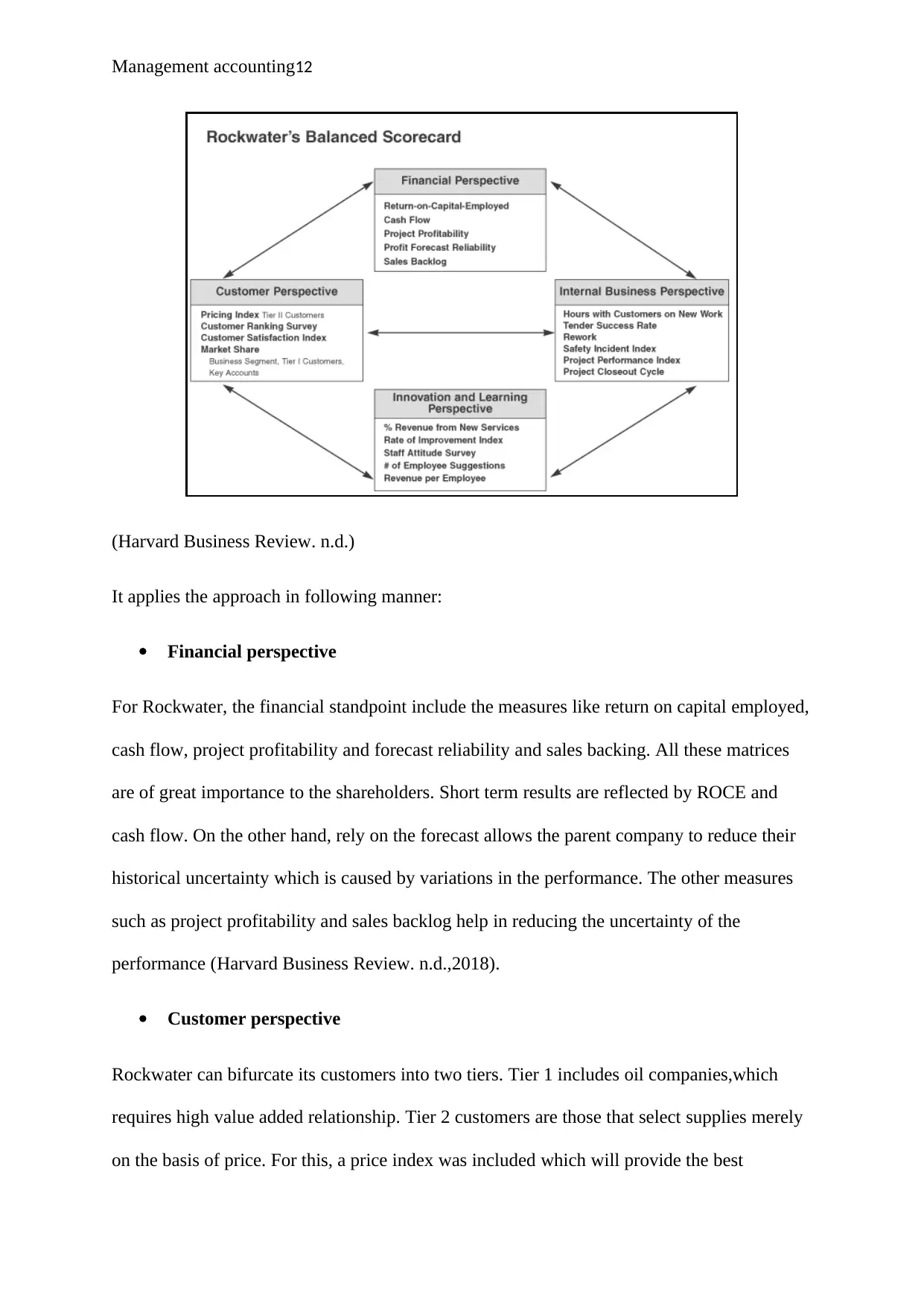
Management accounting12
(Harvard Business Review. n.d.)
It applies the approach in following manner:
Financial perspective
For Rockwater, the financial standpoint include the measures like return on capital employed,
cash flow, project profitability and forecast reliability and sales backing. All these matrices
are of great importance to the shareholders. Short term results are reflected by ROCE and
cash flow. On the other hand, rely on the forecast allows the parent company to reduce their
historical uncertainty which is caused by variations in the performance. The other measures
such as project profitability and sales backlog help in reducing the uncertainty of the
performance (Harvard Business Review. n.d.,2018).
Customer perspective
Rockwater can bifurcate its customers into two tiers. Tier 1 includes oil companies,which
requires high value added relationship. Tier 2 customers are those that select supplies merely
on the basis of price. For this, a price index was included which will provide the best
(Harvard Business Review. n.d.)
It applies the approach in following manner:
Financial perspective
For Rockwater, the financial standpoint include the measures like return on capital employed,
cash flow, project profitability and forecast reliability and sales backing. All these matrices
are of great importance to the shareholders. Short term results are reflected by ROCE and
cash flow. On the other hand, rely on the forecast allows the parent company to reduce their
historical uncertainty which is caused by variations in the performance. The other measures
such as project profitability and sales backlog help in reducing the uncertainty of the
performance (Harvard Business Review. n.d.,2018).
Customer perspective
Rockwater can bifurcate its customers into two tiers. Tier 1 includes oil companies,which
requires high value added relationship. Tier 2 customers are those that select supplies merely
on the basis of price. For this, a price index was included which will provide the best
Paraphrase This Document
Need a fresh take? Get an instant paraphrase of this document with our AI Paraphraser
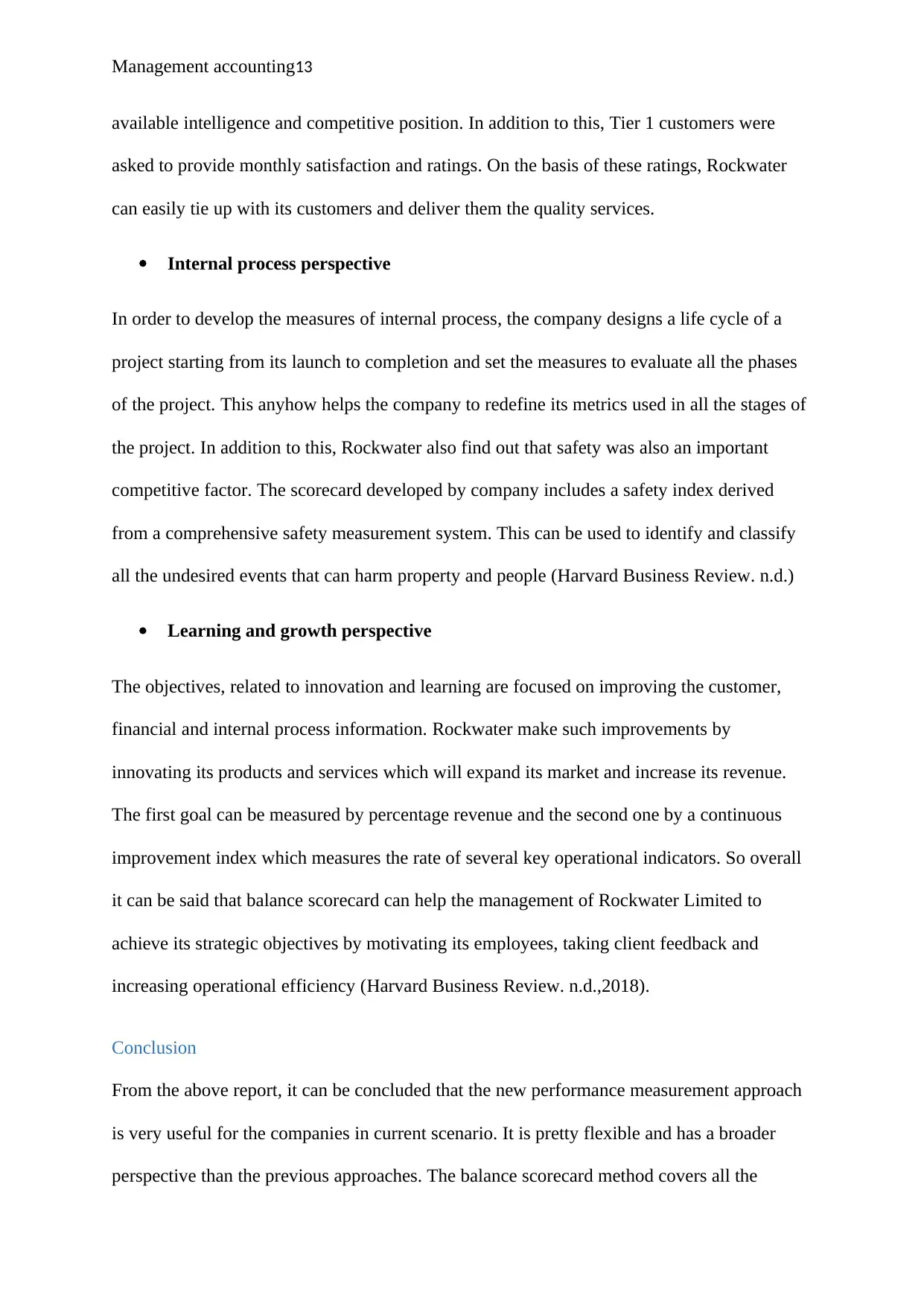
Management accounting13
available intelligence and competitive position. In addition to this, Tier 1 customers were
asked to provide monthly satisfaction and ratings. On the basis of these ratings, Rockwater
can easily tie up with its customers and deliver them the quality services.
Internal process perspective
In order to develop the measures of internal process, the company designs a life cycle of a
project starting from its launch to completion and set the measures to evaluate all the phases
of the project. This anyhow helps the company to redefine its metrics used in all the stages of
the project. In addition to this, Rockwater also find out that safety was also an important
competitive factor. The scorecard developed by company includes a safety index derived
from a comprehensive safety measurement system. This can be used to identify and classify
all the undesired events that can harm property and people (Harvard Business Review. n.d.)
Learning and growth perspective
The objectives, related to innovation and learning are focused on improving the customer,
financial and internal process information. Rockwater make such improvements by
innovating its products and services which will expand its market and increase its revenue.
The first goal can be measured by percentage revenue and the second one by a continuous
improvement index which measures the rate of several key operational indicators. So overall
it can be said that balance scorecard can help the management of Rockwater Limited to
achieve its strategic objectives by motivating its employees, taking client feedback and
increasing operational efficiency (Harvard Business Review. n.d.,2018).
Conclusion
From the above report, it can be concluded that the new performance measurement approach
is very useful for the companies in current scenario. It is pretty flexible and has a broader
perspective than the previous approaches. The balance scorecard method covers all the
available intelligence and competitive position. In addition to this, Tier 1 customers were
asked to provide monthly satisfaction and ratings. On the basis of these ratings, Rockwater
can easily tie up with its customers and deliver them the quality services.
Internal process perspective
In order to develop the measures of internal process, the company designs a life cycle of a
project starting from its launch to completion and set the measures to evaluate all the phases
of the project. This anyhow helps the company to redefine its metrics used in all the stages of
the project. In addition to this, Rockwater also find out that safety was also an important
competitive factor. The scorecard developed by company includes a safety index derived
from a comprehensive safety measurement system. This can be used to identify and classify
all the undesired events that can harm property and people (Harvard Business Review. n.d.)
Learning and growth perspective
The objectives, related to innovation and learning are focused on improving the customer,
financial and internal process information. Rockwater make such improvements by
innovating its products and services which will expand its market and increase its revenue.
The first goal can be measured by percentage revenue and the second one by a continuous
improvement index which measures the rate of several key operational indicators. So overall
it can be said that balance scorecard can help the management of Rockwater Limited to
achieve its strategic objectives by motivating its employees, taking client feedback and
increasing operational efficiency (Harvard Business Review. n.d.,2018).
Conclusion
From the above report, it can be concluded that the new performance measurement approach
is very useful for the companies in current scenario. It is pretty flexible and has a broader
perspective than the previous approaches. The balance scorecard method covers all the
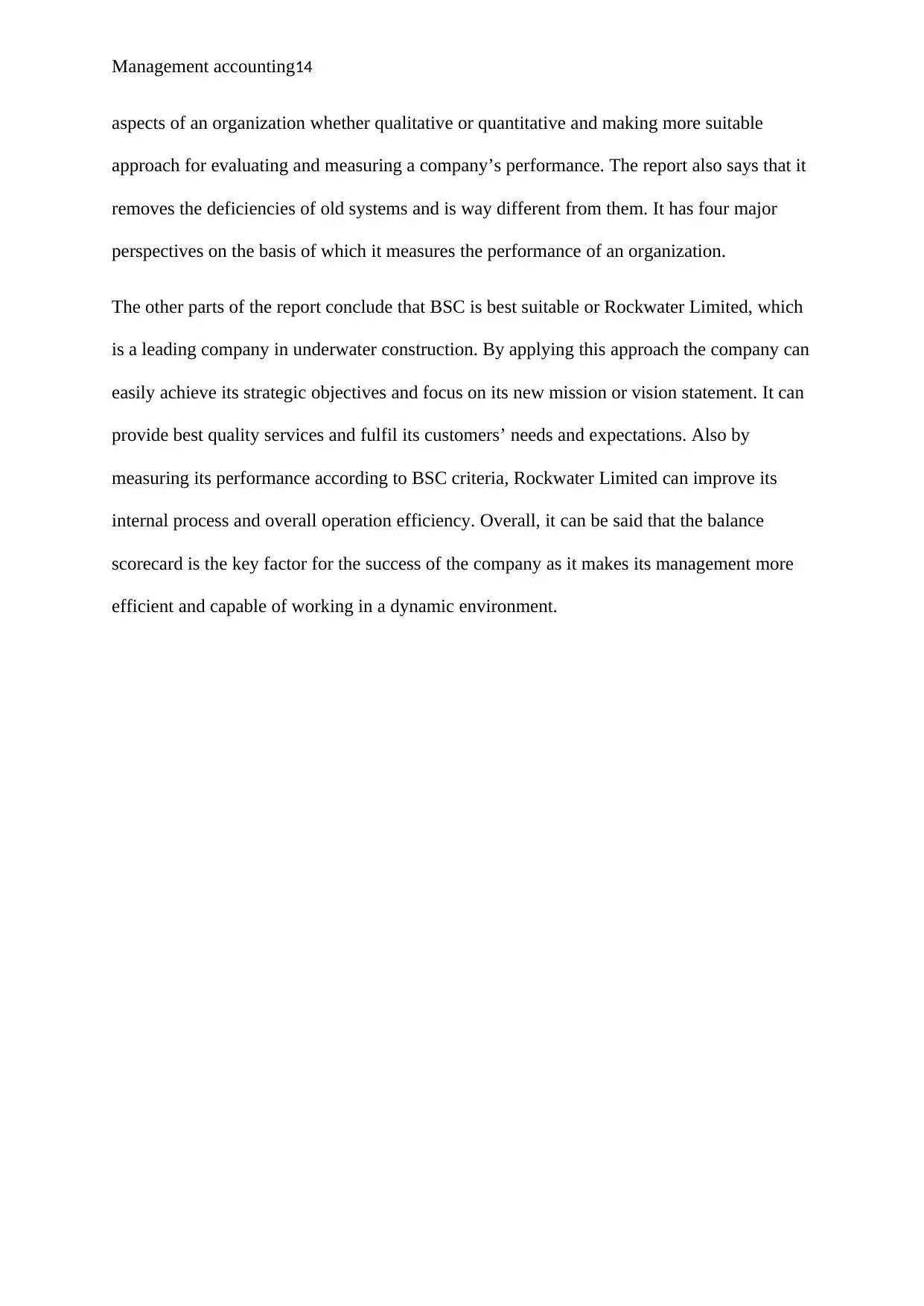
Management accounting14
aspects of an organization whether qualitative or quantitative and making more suitable
approach for evaluating and measuring a company’s performance. The report also says that it
removes the deficiencies of old systems and is way different from them. It has four major
perspectives on the basis of which it measures the performance of an organization.
The other parts of the report conclude that BSC is best suitable or Rockwater Limited, which
is a leading company in underwater construction. By applying this approach the company can
easily achieve its strategic objectives and focus on its new mission or vision statement. It can
provide best quality services and fulfil its customers’ needs and expectations. Also by
measuring its performance according to BSC criteria, Rockwater Limited can improve its
internal process and overall operation efficiency. Overall, it can be said that the balance
scorecard is the key factor for the success of the company as it makes its management more
efficient and capable of working in a dynamic environment.
aspects of an organization whether qualitative or quantitative and making more suitable
approach for evaluating and measuring a company’s performance. The report also says that it
removes the deficiencies of old systems and is way different from them. It has four major
perspectives on the basis of which it measures the performance of an organization.
The other parts of the report conclude that BSC is best suitable or Rockwater Limited, which
is a leading company in underwater construction. By applying this approach the company can
easily achieve its strategic objectives and focus on its new mission or vision statement. It can
provide best quality services and fulfil its customers’ needs and expectations. Also by
measuring its performance according to BSC criteria, Rockwater Limited can improve its
internal process and overall operation efficiency. Overall, it can be said that the balance
scorecard is the key factor for the success of the company as it makes its management more
efficient and capable of working in a dynamic environment.
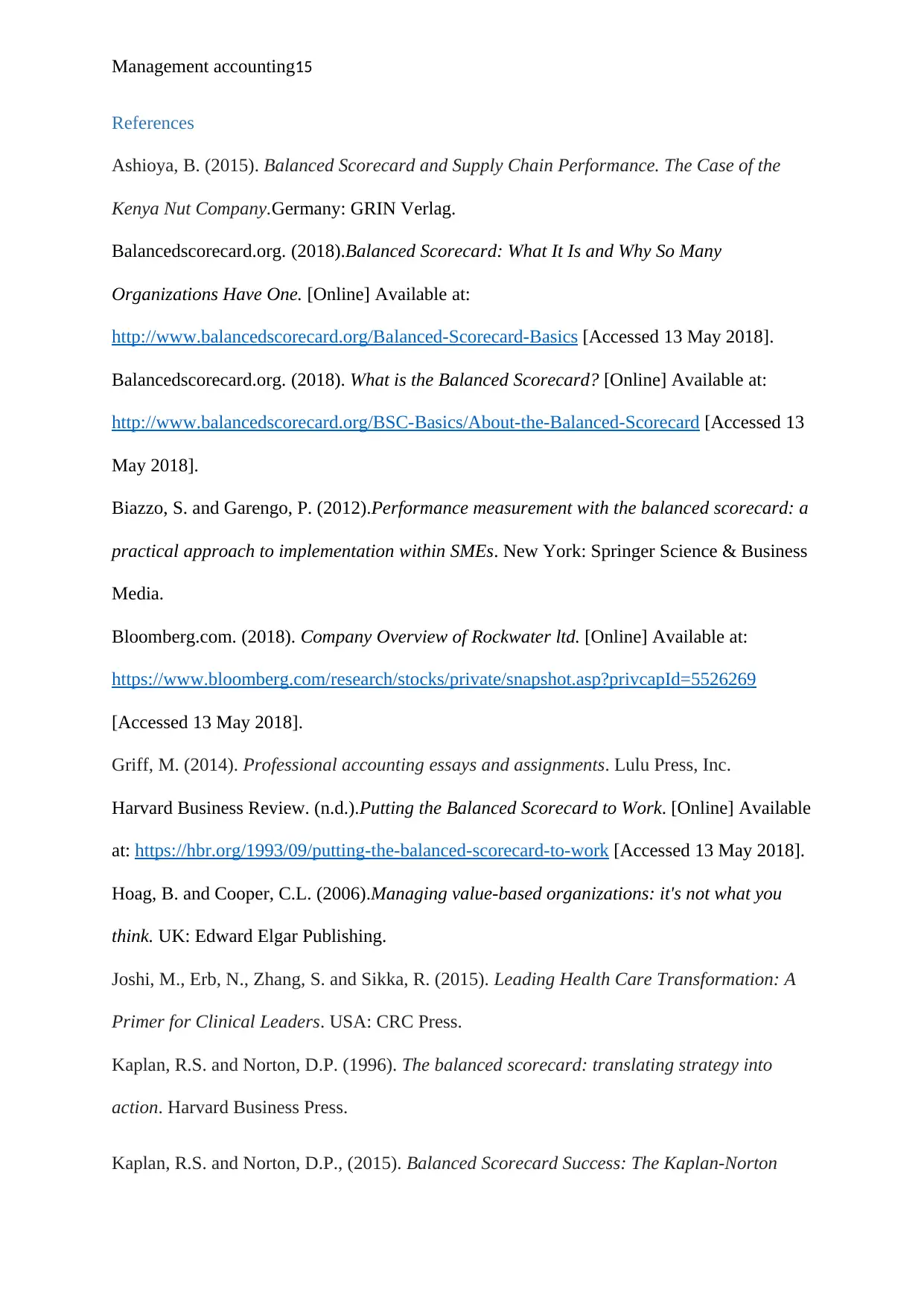
Management accounting15
References
Ashioya, B. (2015). Balanced Scorecard and Supply Chain Performance. The Case of the
Kenya Nut Company.Germany: GRIN Verlag.
Balancedscorecard.org. (2018).Balanced Scorecard: What It Is and Why So Many
Organizations Have One. [Online] Available at:
http://www.balancedscorecard.org/Balanced-Scorecard-Basics [Accessed 13 May 2018].
Balancedscorecard.org. (2018). What is the Balanced Scorecard? [Online] Available at:
http://www.balancedscorecard.org/BSC-Basics/About-the-Balanced-Scorecard [Accessed 13
May 2018].
Biazzo, S. and Garengo, P. (2012).Performance measurement with the balanced scorecard: a
practical approach to implementation within SMEs. New York: Springer Science & Business
Media.
Bloomberg.com. (2018). Company Overview of Rockwater ltd. [Online] Available at:
https://www.bloomberg.com/research/stocks/private/snapshot.asp?privcapId=5526269
[Accessed 13 May 2018].
Griff, M. (2014). Professional accounting essays and assignments. Lulu Press, Inc.
Harvard Business Review. (n.d.).Putting the Balanced Scorecard to Work. [Online] Available
at: https://hbr.org/1993/09/putting-the-balanced-scorecard-to-work [Accessed 13 May 2018].
Hoag, B. and Cooper, C.L. (2006).Managing value-based organizations: it's not what you
think. UK: Edward Elgar Publishing.
Joshi, M., Erb, N., Zhang, S. and Sikka, R. (2015). Leading Health Care Transformation: A
Primer for Clinical Leaders. USA: CRC Press.
Kaplan, R.S. and Norton, D.P. (1996). The balanced scorecard: translating strategy into
action. Harvard Business Press.
Kaplan, R.S. and Norton, D.P., (2015). Balanced Scorecard Success: The Kaplan-Norton
References
Ashioya, B. (2015). Balanced Scorecard and Supply Chain Performance. The Case of the
Kenya Nut Company.Germany: GRIN Verlag.
Balancedscorecard.org. (2018).Balanced Scorecard: What It Is and Why So Many
Organizations Have One. [Online] Available at:
http://www.balancedscorecard.org/Balanced-Scorecard-Basics [Accessed 13 May 2018].
Balancedscorecard.org. (2018). What is the Balanced Scorecard? [Online] Available at:
http://www.balancedscorecard.org/BSC-Basics/About-the-Balanced-Scorecard [Accessed 13
May 2018].
Biazzo, S. and Garengo, P. (2012).Performance measurement with the balanced scorecard: a
practical approach to implementation within SMEs. New York: Springer Science & Business
Media.
Bloomberg.com. (2018). Company Overview of Rockwater ltd. [Online] Available at:
https://www.bloomberg.com/research/stocks/private/snapshot.asp?privcapId=5526269
[Accessed 13 May 2018].
Griff, M. (2014). Professional accounting essays and assignments. Lulu Press, Inc.
Harvard Business Review. (n.d.).Putting the Balanced Scorecard to Work. [Online] Available
at: https://hbr.org/1993/09/putting-the-balanced-scorecard-to-work [Accessed 13 May 2018].
Hoag, B. and Cooper, C.L. (2006).Managing value-based organizations: it's not what you
think. UK: Edward Elgar Publishing.
Joshi, M., Erb, N., Zhang, S. and Sikka, R. (2015). Leading Health Care Transformation: A
Primer for Clinical Leaders. USA: CRC Press.
Kaplan, R.S. and Norton, D.P. (1996). The balanced scorecard: translating strategy into
action. Harvard Business Press.
Kaplan, R.S. and Norton, D.P., (2015). Balanced Scorecard Success: The Kaplan-Norton
Secure Best Marks with AI Grader
Need help grading? Try our AI Grader for instant feedback on your assignments.
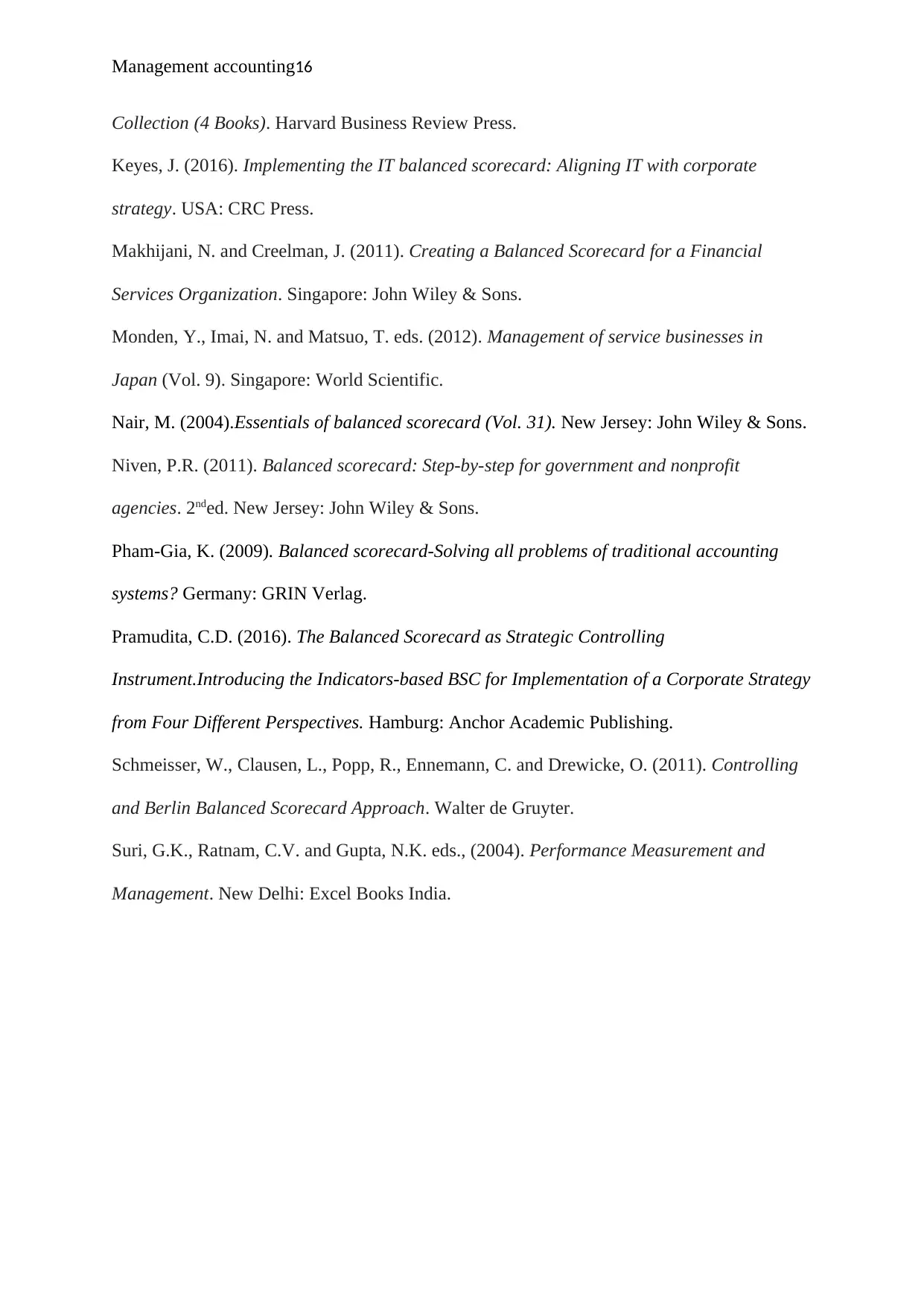
Management accounting16
Collection (4 Books). Harvard Business Review Press.
Keyes, J. (2016). Implementing the IT balanced scorecard: Aligning IT with corporate
strategy. USA: CRC Press.
Makhijani, N. and Creelman, J. (2011). Creating a Balanced Scorecard for a Financial
Services Organization. Singapore: John Wiley & Sons.
Monden, Y., Imai, N. and Matsuo, T. eds. (2012). Management of service businesses in
Japan (Vol. 9). Singapore: World Scientific.
Nair, M. (2004).Essentials of balanced scorecard (Vol. 31). New Jersey: John Wiley & Sons.
Niven, P.R. (2011). Balanced scorecard: Step-by-step for government and nonprofit
agencies. 2nded. New Jersey: John Wiley & Sons.
Pham-Gia, K. (2009). Balanced scorecard-Solving all problems of traditional accounting
systems? Germany: GRIN Verlag.
Pramudita, C.D. (2016). The Balanced Scorecard as Strategic Controlling
Instrument.Introducing the Indicators-based BSC for Implementation of a Corporate Strategy
from Four Different Perspectives. Hamburg: Anchor Academic Publishing.
Schmeisser, W., Clausen, L., Popp, R., Ennemann, C. and Drewicke, O. (2011). Controlling
and Berlin Balanced Scorecard Approach. Walter de Gruyter.
Suri, G.K., Ratnam, C.V. and Gupta, N.K. eds., (2004). Performance Measurement and
Management. New Delhi: Excel Books India.
Collection (4 Books). Harvard Business Review Press.
Keyes, J. (2016). Implementing the IT balanced scorecard: Aligning IT with corporate
strategy. USA: CRC Press.
Makhijani, N. and Creelman, J. (2011). Creating a Balanced Scorecard for a Financial
Services Organization. Singapore: John Wiley & Sons.
Monden, Y., Imai, N. and Matsuo, T. eds. (2012). Management of service businesses in
Japan (Vol. 9). Singapore: World Scientific.
Nair, M. (2004).Essentials of balanced scorecard (Vol. 31). New Jersey: John Wiley & Sons.
Niven, P.R. (2011). Balanced scorecard: Step-by-step for government and nonprofit
agencies. 2nded. New Jersey: John Wiley & Sons.
Pham-Gia, K. (2009). Balanced scorecard-Solving all problems of traditional accounting
systems? Germany: GRIN Verlag.
Pramudita, C.D. (2016). The Balanced Scorecard as Strategic Controlling
Instrument.Introducing the Indicators-based BSC for Implementation of a Corporate Strategy
from Four Different Perspectives. Hamburg: Anchor Academic Publishing.
Schmeisser, W., Clausen, L., Popp, R., Ennemann, C. and Drewicke, O. (2011). Controlling
and Berlin Balanced Scorecard Approach. Walter de Gruyter.
Suri, G.K., Ratnam, C.V. and Gupta, N.K. eds., (2004). Performance Measurement and
Management. New Delhi: Excel Books India.
1 out of 17
Related Documents
Your All-in-One AI-Powered Toolkit for Academic Success.
+13062052269
info@desklib.com
Available 24*7 on WhatsApp / Email
![[object Object]](/_next/static/media/star-bottom.7253800d.svg)
Unlock your academic potential
© 2024 | Zucol Services PVT LTD | All rights reserved.





